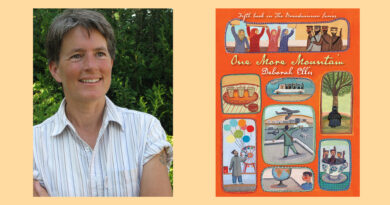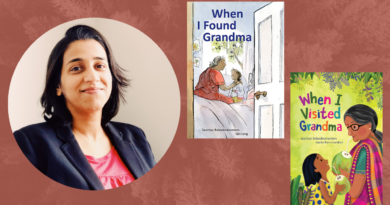New year? New graphic novels to engross, enlighten and entertain young readers

The Spirit of Denendeh by Richard Van Camp, Scott B. Henderson and Donovan Yaciuk
Published by Highwater Press (distributed in Canada by University of Toronto Press Distribution)
A Blanket of Butterflies, first in The Spirit of Denendeh graphic novel series, is a magical and meaningful adventure set in the world of the Tłı̨chǫ Dene, a Dene First Nations people living in Canada’s Northwest Territories. Compelling and visually stunning, this cross-cultural tale deserves a place in classroom and school libraries across Canada and around the globe.
In A Blanket of Butterflies, a fictional Tłı̨chǫ Dene boy named Sonny helps to resolve a real-life mystery that has long fascinated writer and Fort Smith NYT resident Richard Van Camp. The mystery? The incongruous presence of a suit of samurai armour in the Fort Smith museum. Tne graphic novel imagines not just an origin but a destiny for the armour. Shinobu, a Japanese man, has come to Fort Smith to reclaim the armour and a missing sword, which belonged to his grandfather. Sonny and his wise and powerful grandmother aid Shinobu in what turns out to be a dangerous personal, familial, and cultural quest.
The story is dramatic, action-packed and unexpectedly educational. Van Camp uses Sonny’s role in the mystery to bring to life nine “Dene Laws” and unpack unexpected intersections between the experiences of Indigenous peoples and Japanese Canadians during and after the Second World War. Afterwords by author Dr. R. Scott Sheffield and the Nikkei National Museum & Cultural Centre’s Carolyn Nakagawa fill in helpful additional detail.
Scott B. Henderson’s artwork is simply stunning. His detailed linework, paired with Donovan Vachuk’s arresting colours, brings each character to vivid life and conjures exquisitely the tangibility of Fort Smith landmarks and the interwoven presence of the spirit world beyond. A Blanket of Butterflies is a history lesson wrapped in a mystery inside a gorgeous, uplifting and life-affirming tale about our connections to one another. I can’t recommend it highly enough.

Five Stalks of Grain by Adrian Lysenko
Illustrated by Ivanka Theodosia Galadza
Published by University of Calgary Press
Given the atrocities being committed by Russia in its present-day invasion of Ukraine, the Ukraine-set historical graphic novel Five Stalks of Grain feels shockingly current. Adrian Lysenko’s sparsely worded graphic novel, which is strikingly illustrated by Ivanka Theodosia Galadza, tells one girl’s story of tragedy and survival during the Holodomor. This genocidal “death inflicted by starvation” was perpetrated on millions of Ukrainians from 1932 to 1933 by Josef Stalin’s Soviet regime. The graphic novel’s title refers to the Stalinist decree that forbade any Ukrainian man, woman or child from taking even five stalks of grain from any field anywhere – on penalty of imprisonment or death – despite the fact that they were starving, while the Soviets shipped their country’s grain to Russia and sold it to the West.
Lysenko’s tale opens with the grim fate of Nadia and Taras’ parents at the hands of the Soviets. Left alone, the two children need somehow to escape. But how and to where in the occupied vastness of Ukraine, which is being looted by all food – and with it, of all charity and humanity? The pair pick their way through a bewildering and deadly landscape. The snow-covered veneer barely covers the dead and the dying, and seeming acts of kindness are often preludes to survival-motivated savagery and betrayal. Five Stalks of Grain brings the horrifying stakes to life: there is no sugar-coating or simplification of this hellish situation. And the tale doesn’t end well – or even clearly – for the pair.
Worthy of special note is the black-and-white art by Ukrainian-Canadian artist Ivanka Theodosia Galadza. Drawing on Ukrainian artistic traditions, her woodcut-like style emphasizes fine line work, blocky black patches and dramatic colour inversions. The text’s sparseness is afforded depth and dimension by this striking artwork, which disorients and demands careful attention. The collective effect is to keep us immersed, yet off-balance – just like the protagonists.
Five Stalks of Grain is shocking, heartbreaking and teeth-gnashingly relevant. The graphic novel is a profound vehicle for the discussion of politics, war, genocide, the plight of refugees – and the enduring historical fact of Ukrainian resilience. A work of profound art, it deserves an important place in classrooms and school and personal libraries.

Living with Viola by Rosena Fung
Published by Annick Press
Living with Viola by Rosena Fung is a compassionate and recognizably true-to-life account of a ten-year-old-girl’s mental health challenges connected to self-doubt, racism, the tribulations of joining a new school, and the relationships and dynamics of her middle-school friend group. The work has an important message, and it’s also a dynamic and engrossing read.
We meet ten-year-old Olivia as she joins a new school, where she feels overwhelmingly alone. The space of her loneliness is filled by the shadowy, cruel voice of her second self – Viola – who voices crippling self-talk about Olivia’s low value and worthlessness. Living with Viola is excruciating. Chasing Olivia from one situation to the next, Viola finds confirmations of her low worth literally everywhere: in the dynamics of her extended family, her parents’ judgment, cultural differences, interactions with her friends, worries over her perceived immaturity – and on and on.
Fung deftly and sensitively portrays the dynamics of runaway anxiety and panic disorder. These are common situations: young readers will feel the relevance to themselves or to someone they know. And the individual stressors compound and multiply one another in dynamic and mesmerizing imagination-scapes centered around Viola’s hectoring presence. Fung’s loud, swirling artwork depicts Olivia caught in an undertow of crippling self-criticism that leads her to make choices that only exacerbate her initial feelings of anxiety and isolation. Living with Viola not only does an excellent job of manifesting this problem – which is an externalization of the kind of disorder that Fung herself grappled with as the child of immigrant parents born in Hong Kong. The last part of the book provides a hopeful and artful account of how Olivia begins to live with Viola in a sustainable, manageable way. Spoiler alert: it involves self-acceptance plus specific kinds of help provided by doctors and teachers and family and friends.
Endearing, energetic and never preachy, Living with Viola opens up important discussions about mental illness, cultural differences and self-acceptance. Highly recommended.

Scout is NOT a Band Kid by Jade Armstrong
Published by RH Graphic, an imprint of Random House Children’s Books
Scout is NOT a Band Kid is an energetic, entertaining debut for Toronto writer-artist Jade Armstrong. Scout is a geek who simply must meet her idol Pristine Wong, creator of Posaune: Warrior Princess, which is Scout’s favorite anime and cosplay. The problem: Scout has no way of getting to AlmonteFest in New Almonte, where Wong will appear at the end of the school year. At least she doesn’t, until she learns that the school’s Holy Moly 7/8 Band will be make an end-of-year trip to play at this festival.
So her path is set. Though Scout has no interest in band and no experience playing an instrument, she uses half-truths and fakery to worm her way into the band. Once there, she sets out to do as little as possible, including not learning the trombone. Of course, this brings her into conflict with her new bandmates, most notably Merrin, the ultra-serious trombone section leader who is counting on success at the festival for various reasons. Conflict – and hilarity and learning – ensue.
Scout is a wonderful character: sardonic, self-reliant, scattered, and in over her head. Scout is NOT a Band Kid is the story of how her band misadventures – with unexpected contributions from new friends, plus re-evaluations of old friends – help Scout stop defining herself by what she’s not. Over the course of the story, she begins to understand who she really is and what really matters, and how to be true to herself and of service to her friends. Oh, and maybe, just maybe . . . how she can meet her idol Pristine Wong.
Middle school readers will revel in the oversized presence of Scout herself, and enjoy smaller details like the “power ratings” provided when we meet new characters and the hilarious footnotes Armstrong includes to explain the arcane realities of life in Canada. A unique voice, wonderful cartoony art and a big, big heart make this a true “funny book” that middle school readers will truly enjoy.
© Scott Sneddon, SesayArts Magazine, 2022
About The Author
Scott Sneddon
Scott Sneddon is Senior Editor on SesayArts Magazine, where he is also a critic and contributor.
Visit About Us > Meet the Team to read Scott’s full bio …




